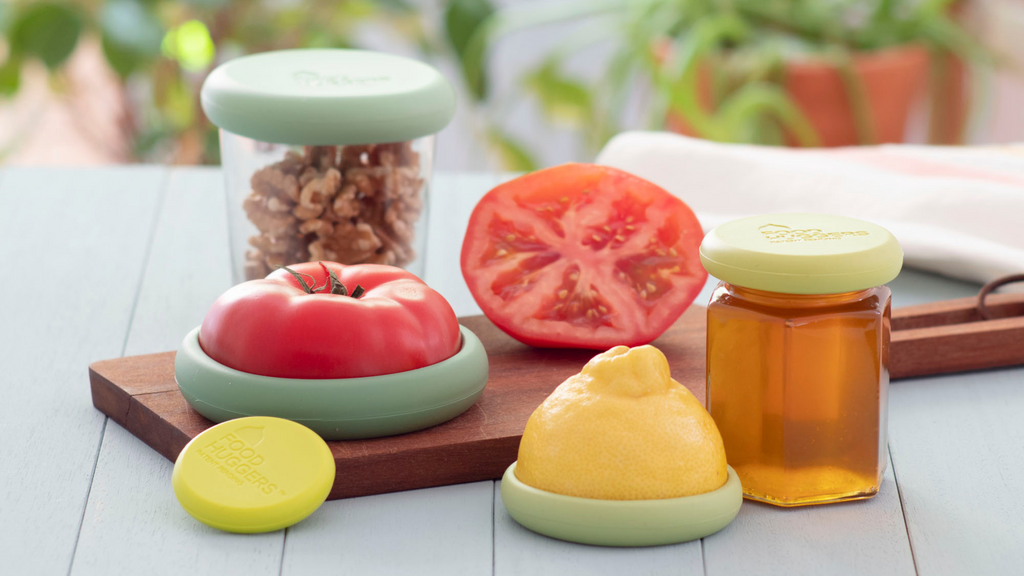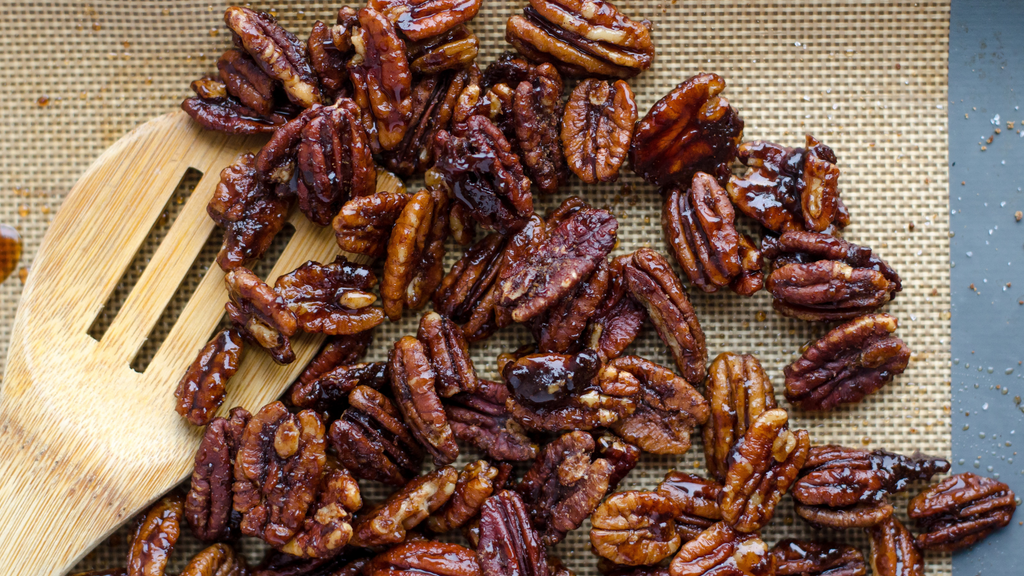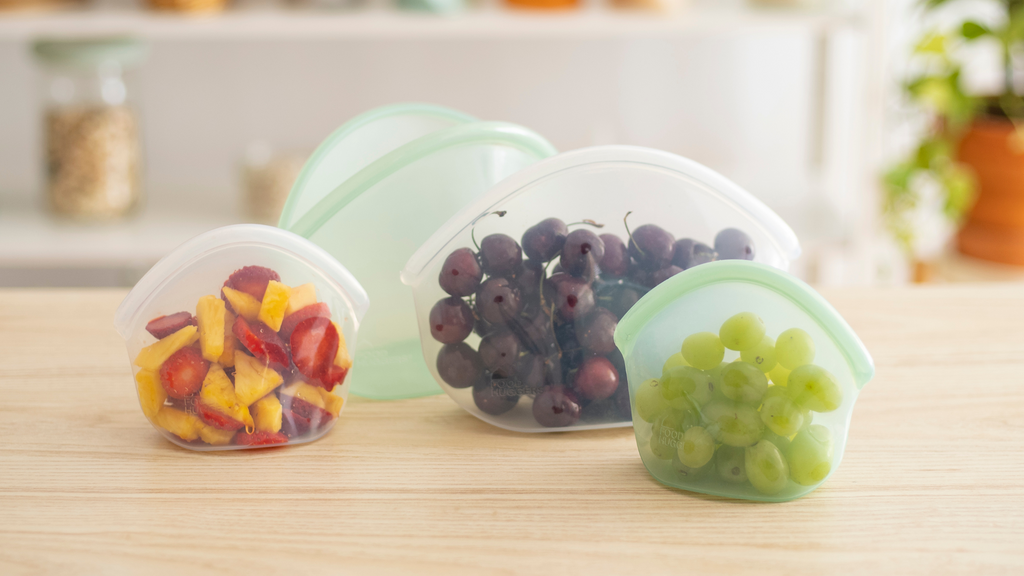The kitchen is a center of activity in your home — from early-morning oatmeal to mid-day salads to late night tea chats.
But unfortunately, the kitchen can also be a major source of waste, both from food and packaging.
One way to reduce waste in your kitchen is by choosing eco-friendly kitchen tools over plastic or disposable ones. In this article, we’ve identified 11 sustainable swaps that are both simple and high-impact, helping you reduce waste without compromising on quality or convenience.

1. Reusable Paper Towels
A roll of paper towels is a staple on many countertops. While they can be handy for quick cleanups, paper towels are hard on the environment. Many paper towels are made from virgin trees, which contributes to deforestation.
Making paper towels also uses large amounts of water and chemicals for processing. And since they’re single-use, they’re piling up in landfills at the rate of 13 billion pounds a year.
Reusable paper towels are an easy sustainable swap that helps you reduce waste and save money. Shops like Marley’s Monsters sell “Unpaper Towels” with cute prints, but you can easily make your own, too.
Simply cut up old towels, cloths, or even cotton t-shirts into your desired size. Then tuck them into your kitchen drawer and use them, wash them, and reuse them again and again.

2. Food Huggers
Another top contributor to trash in the kitchen is single-use plastic wrap and foil. These disposable wraps are pricey — and often fail to give you an airtight seal to keep food fresh, which can lead to more food waste at home.
When it comes to eco-friendly kitchen tools, Food Huggers are an all-time customer favorite. They’re designed with a nature-inspired seal that snugly “hugs” your food, keeping out air and bacteria to help your leftovers last.
You can replace single-use wrap with Food Huggers by:
- Using Food Huggers to store fruit and vegetable halves
- Sealing cans or jars
- Covering small ramekins (see below for another great reusable bowl cover!)
Food Huggers are infinitely reusable and dishwasher safe, making them an ultra-convenient eco-friendly kitchen tool. And since they come in five sizes, you can store everything from limes to grapefruits without any waste!
3. Food Scrap Collection Bin
When food scraps end up in landfills, they release a potent greenhouse gas called methane as they decompose. You can keep food out of the landfill and promote healthier soil by adding a scrap collection bin to your zero-waste kitchen toolkit.
You can use an empty ice cream bucket, a large jar, or even a Hugger Bag to hold your scraps. We recommend keeping your bin in the freezer until you have enough to add to compost.
A few items you can compost include:
- Fruit and vegetable scraps
- Produce peels or cores
- Egg shells
- Grains like pasta or oats
- Coffee grounds
Avoid adding anything with meat, dairy, or oil to compost since these items are prone to spoiling and attract pests. If you’re sending your food scraps to a composting facility, be sure to check their list of acceptable materials first. And if you want to start composting at home, check out this helpful composting tutorial from Food Print.
4. Glass Spray Bottles
Conventional cleaner typically comes in plastic bottles that aren’t designed to be reused or refilled. And since manufacturers aren’t required to list all the ingredients on the bottle, it can be tricky to know what you’re bringing into your home.
Glass spray bottles make an effortless sustainable swap. This reusable glass spray bottle from Grove Co. is one of our favorites — it even has an easy snap-on label.
You can fill, clean, and refill them indefinitely, and use them just like a conventional bottle of cleaner. We love mixing up our own non-toxic kitchen cleaner and adding them to a bottle for low-waste cleaning.
To make a simple DIY kitchen cleaner, just add one part white vinegar and three parts filtered water to your spray bottle. For a fresh scent, use a few drops of essential oils like tea tree, lemon, or peppermint. Then shake gently, spritz, and enjoy plastic-free cleaning power.

5. Reusable Bowl Lids
Just like Food Huggers, Reusable Bowl Lids are eco-friendly kitchen tools made to help you keep your food fresh without relying on single-use solutions. And they free you from the constant hunt to find the right lid every time you want to store leftovers!
Reusable Bowl Lids range from X-Small to X-Large, and have flexible silicone sides that seal any bowl between 3.75” and 9.25”. With a clear glass top, you can stack your bowls and easily see what’s inside — helping you tidy your fridge and cut down on food waste in your kitchen.
Use your Reusable Bowl Lids in place of plastic wrap or foil to store bowls of condiments, leftovers, or even meals prepped and ready for the next day.
6. Cloth Produce Bags
Single-use plastic produce bags are flimsy and difficult to recycle, so they often end up in the landfill or worse, as litter. Using cloth produce bags is a sustainable swap that lets you ditch plastic while still keeping your produce safe and organized.
You can take your produce bags while shopping to hold loose items like apples or protect delicate herbs and greens. Store full produce bags in the pantry or fridge — cloth lets your fruits and veggies “breathe” to stay fresh longer. If your bags get dirty, just wash and dry them to use again.
Two of our go-to choices for quality produce bags that last are Eco Roots’ Organic Cotton Produce Bag Set and Lotus Mesh Produce Bags. Or, to make your own bags, try this DIY produce bag tutorial that’s perfect for even beginning sewers.
7. Reusable Grocery Bags
At checkouts across the country, plastic grocery bags fill up at increasing rates. The average American shopper uses 365 single-use grocery bags per year, adding up to over 100 billion bags nationwide. By contrast, the average Danish shopper uses just four disposable grocery bags annually.
One of the biggest problems with plastic grocery bags is that they’re used for only a few minutes before being thrown away. Then, like produce bags, they often end up in the environment as litter. Unfortunately, animals like sea turtles often mistake them for food and eat them.
You can use less plastic by bringing your own reusable grocery bags to the grocery store. Clean and reuse your bags as many times as you can to reduce your carbon footprint. For easy access (and to help you remember them), try keeping them in the trunk of your car.

8. Avocado Huggers
Avocados are notorious for browning as soon as you cut them. Avocado Huggers are custom-shaped to fit avocados for maximum freshness.
Simply slip the leftover avocado half into the Avocado Hugger and the silicone lip hugs the peel to keep the flesh from browning. Thanks to a collapsible seed pocket, you can store avocados with or without the pit.
We love multipurpose tools in our zero waste kitchen, so we also use our Avocado Huggers to store other irregularly shaped fruits and vegetables like pears, mangos, or small squashes.

9. Silicone Baking Mats
This sustainable swap is waste-free and mess-free, which is a win-win for you. Silicone baking mats are a handy eco-friendly kitchen tool that take the place of single-use parchment paper, wax paper, or foil. They’re non-stick and flexible, and easy to clean in the sink or the dishwasher.
Use silicone baking mats to:
- Line baking trays for quick cleanup
- Freeze berries before storing them
- Roll out sticky dough on the counter
- Prepare fragile items like pastries or chocolates
With proper care, a good set of silicone baking mats can last years and replace heaps of single-use items. Be sure to match the size of your baking sheets when you purchase them!
10. Plastic-Free Soap
Soap is a must when tidying up, but plastic soap bottles create a real mess for the planet. Instead, make a sustainable swap to plastic-free soap. There are two main ways you can do this.
First, by using solid bar soaps instead of liquid soap. You can find bar forms of hand soap and dish soap, like this long-lasting dish bar from The Earthling Co. Then simply keep them on a dish next to the sink and lather on your hands or a dish brush.
Second, by refilling soap bottles from bulk bottles or plastic-free refills. Some brands like Grove Co. offer eco-friendly liquid soap refills or even solid refills you dissolve in water at home.
You can try one or both of these, then wash up as usual while creating less waste.

11. Hugger Bags
Our final eco-friendly kitchen tool is as versatile as it is convenient. Hugger Bags are silicone storage bags that let you say goodbye to single-use plastic baggies. You can use them to store snacks, sandwiches, leftovers, and other kitchen items you’d normally keep in a zip-top bag
Unlike disposable bags, they’re designed to be reused infinitely. Just fill them up and seal the top. The stand-up bottom helps prevent leaks. And since they’re dishwasher safe, you can easily get them ready for the next batch of food.
Simple Steps to a Zero Waste Kitchen
We hope you find a swap on this list that works for you. Choosing eco-friendly kitchen tools is a powerful way to reduce your plastic waste and carbon footprint. And by choosing simple, high-impact swaps, you can still enjoy the convenience you need in your busy kitchen!
Do you have more sustainable kitchen swaps or just want to share your experience with our Food Huggers? We'd love to hear from you.
At Food Huggers, a woman-owned business and Certified B Corp, we highly value your feedback and engagement.
Reach out to us on Facebook, Instagram, and YouTube. It’s where we share our best sustainability tips, exciting new arrivals and exclusive deals.
